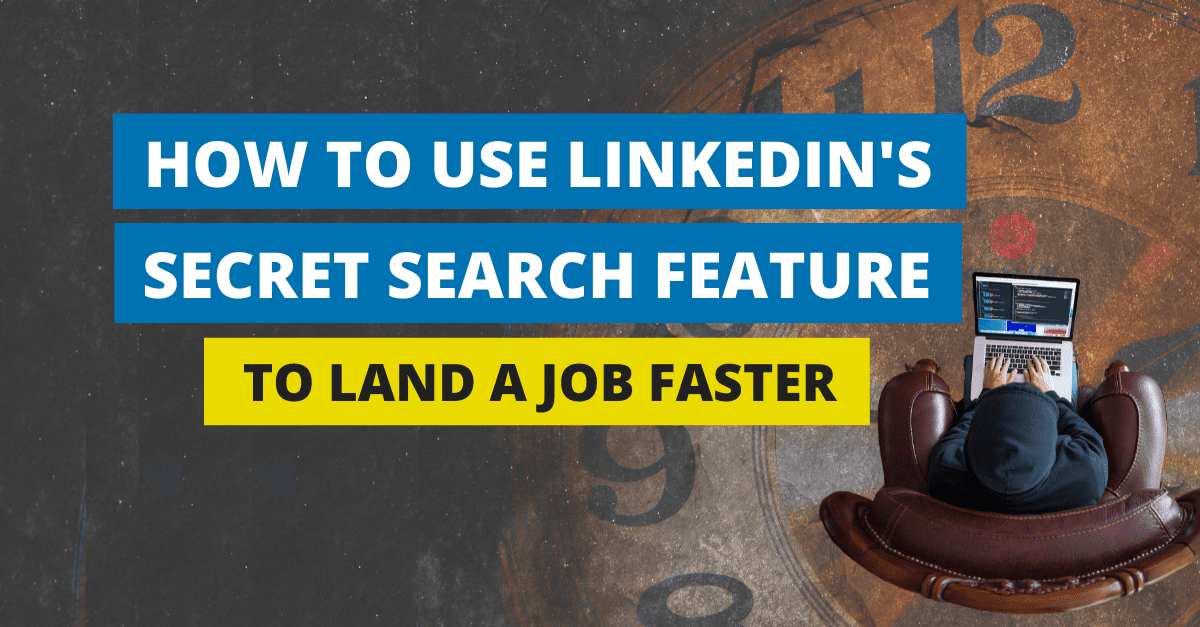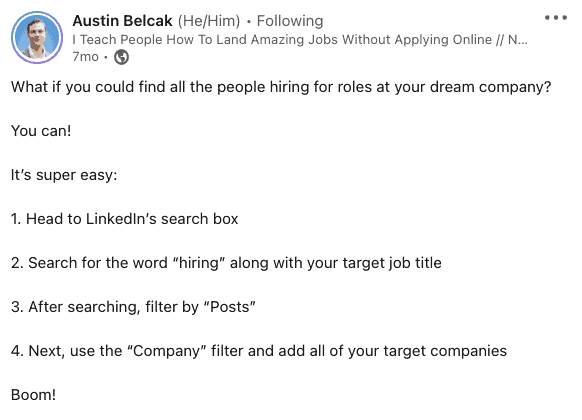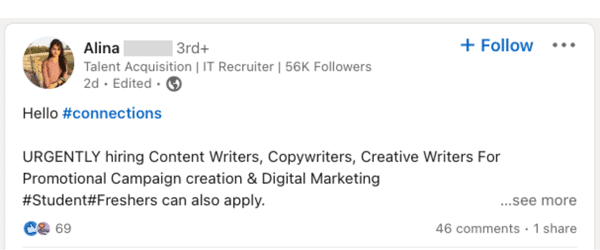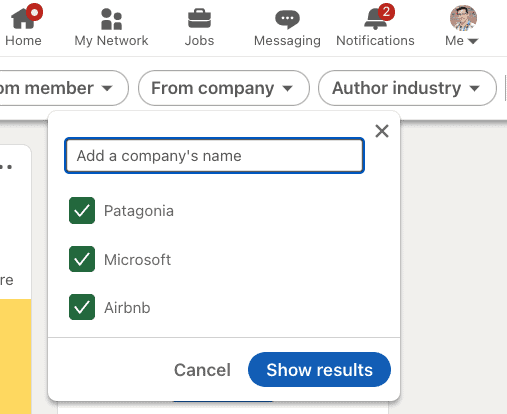
How to Use LinkedIn to Get a Job (Using LinkedIn's Secret Search Feature)
According to studies, the typical job opening attracts 250 job applications on average.
That means that on average you have a 1 in 250 chance of getting the job.
When I first started applying to jobs, I did what most people do.
I went on LinkedIn, clicked the “Jobs” button in the top navigation menu and searched for my desired role.
Now, there’s nothing wrong with doing this.
👉 But, this is what most people do. And, as the saying goes, “average actions lead to average results.”
Now, there are some simple ways to improve your chances, some of which I cover in our free resume course.
These include optimizing your bullet points, adding the “two magic words” to your resume, and implementing the 17 best resume hacks we've covered before.
These will put you above 80% of all other candidates. That means that you now have a 1 in 50 shot.
Not bad.
👉 But how can you get into that final top 1% of job candidates?
In this post, I’ll show you:
- How to use a special LinkedIn search to find “active” roles
- How to find the people on LinkedIn who are looking for candidates exactly like you
- How to get your job application noticed on LinkedIn without being “salesy”
Let’s jump right in!

The Best Way to Use LinkedIn for Job Search
Once you’ve optimized your resume you'll have the raw materials needed. But, this still leaves the question of how you should apply to jobs on LinkedIn.
As we’ve discussed before, not all job search sites are created equal. Certain job search sites are better than others. Here is my curated list of the 40 best job search sites, one of which is LinkedIn.
Let’s look at how we can use LinkedIn’s advanced search features to find jobs that are “actively” hiring.
Passive Hiring vs Active Hiring
There are two types of jobs on LinkedIn. With one type you’ll be sending applications into the abyss where you never hear back and with the other you’ll get hired (sometimes in as little as 3 weeks!).
Passive Hiring
The first type of job opening on LinkedIn is what I call passive hiring. This is when a company says, “we should hire someone to take care of X.”
They get their recruiting team to post the job to some job boards and then they interview people at a leisurely pace.
These job openings are perfectly fine, but in many cases they can take forever to actually hire someone because they don’t have any urgency.
Active Hiring
Active hiring, on the other hand, is when a company says, “we need to hire someone to take care of X right away.”
They post the job onto the same job boards, but then they also get everyone at the company to share the job opening to their network on LinkedIn.
👉 These kinds of job openings will get you hired faster and chances are you’ll have a much better interview process.
The Secret Method for Finding Active Job Openings
In a recent post, LinkedIn expert, Austin Belcak, of Cultivated Culture explained a clever method for finding and filtering for the job openings on LinkedIn that are actively hiring.
Austin’s post explained:

Let’s break down this method and how you can use it to improve your job search.
Step #1: Search for Who is Hiring
Rather than going to the “Jobs” tab of LinkedIn, go to the general search bar at the top and type in “hiring” plus your target role.
This is a much better way to get a job through LinkedIn and below I'll explain why.
Let's look at an example.
Here I’ve typed in “Hiring Content Marketing.”

Step #2: Filter by Posts
After you click search, you’ll want to filter the results by “posts.” This will bring up anyone who has posted that they’re actively hiring for the role.

The great thing here is that you can actually see how recently they’ve posted that they’re hiring.
This tells you that they’re actively hiring for the role and that they’re motivated to find someone relatively quickly.
👉 It also tells you that the candidates who they’ve received through their general job post haven’t been the level of quality they’re after.
Here are some examples of the results:



👉 If you’re looking for a job at any company, you can skip to step #4.
Step #3: Filter your Job Search by Company or Industry
If, on the other hand, you’re looking for jobs within certain companies, then you can take the extra step of filtering your results.
To filter by company, simply click on the “From Company” button and type in as many target companies as you’d like.

👉 Note: You can also filter by industry if you’d like a broader search and don’t have any target companies in mind.
Step #4: Reach Out with a Thoughtful LinkedIn Message
Finally, you’ll want to reach out to the person who posted about the hiring opportunity.
The way you reach out here is very important.
First, here’s what NOT to do:
- Don’t reach out asking for the job
- Don’t reach out asking for generic advice
- Don’t reach out asking for a referral
Doing any of the above will guarantee that either you won’t get a response or that you’ll turn the person off from wanting to speak with you.
Instead, use one of these LinkedIn outreach message templates specifically designed for job seekers, or do one of the following:
A) Reach out and ask how they like the company
People like people who are thoughtful about where they work. People also like to give their opinions.
Keep your message short. For example:
Hey Matt,
I saw your post about the Content Marketing role you’re looking for. I’ve been following [name of company] for awhile and I think what you’re doing is very inspiring.
How do you like working there if you don’t mind me asking?Thanks,
[your name]
Remember, keep your message short and to the point. When meeting someone online for the first time, you want to follow the golden networking rule as much as possible.
B) Reach out to let them know you’ve applied
As simple as it sounds, sometimes letting someone know that you’ve applied can really help your job search.
In many cases, they won’t reply, but that’s okay. They’ll still remember your name when they’re sorting through job applications.
A simple outreach message can be:
Hey Matt,
I saw your post that you’re hiring at [company name]. I just wanted to let you know I applied and am looking forward to chatting more in an interview!
Hope all is well!
[your name]
And that’s it! If you follow these steps, along with the resume improvements in our free resume course, you’ll greatly increase your chances of landing a job through LinkedIn.
Remember, the key to a successful job search is to do what other’s won’t.
👉 That doesn’t mean you have to do anything complicated.
Sometimes it can be as simple as doing a targeted job search, finding those active hiring roles, and sending a short, thoughtful LinkedIn outreach message.
If you’d like to learn about other ways you can use LinkedIn to get a job, I recommend watching our free job search courses.
The courses include strategies like the one we just covered that have been successfully used by thousands of job seekers to land their dream roles.
Get 1-on-1 Help
Need to land your job ASAP? Fast forward your job search with some 1-on-1 help! 👇
More from the blog:

Best Resume Builders of 2023 (Pros & Cons + Prices)
Modern resume builders use AI, ATS-friendly templates, and active recommendations to help you build your perfect resume faster than ever before. In this post we’ve rounded up the 5 best resume builders of 2023.
How to Beat the ATS in 25 Minutes | The Ultimate Guide
In this guide I’ll show you how to beat the ats (applicant tracking system), plus I’ll give you 2 ATS-friendly resume templates and a free tool to test if your resume is ATS-friendly.
Like this? Try our free courses!
Tired of sending your job applications into a black hole and never hearing back? Get hired faster with our guided courses all for FREE!
Bogdan Zlatkov is the Founder of GHYC and author of "The Ultimate Guide to Job Hunting", ranked #1 on Google. He has been featured in the Wall Street Journal, Fast Company, HR Dive, and more. At GHYC, Bogdan creates job search courses & tools by working with award-winning career coaches, best-selling authors, and Forbes-Council members. Prior to GHYC, Bogdan led the content programs at LinkedIn Learning.